 | |
| Introduced in | 1934, 1951 |
|---|---|
| Author | Ludwig Bertele |
| Construction | 8 elements in 5 groups |
| Aperture | 4.5 |
Biogon is the brand name of Carl Zeiss for a series of photographic camera lenses, first introduced in 1934. Biogons are typically wide-angle lenses.
 | |
| Introduced in | 1934, 1951 |
|---|---|
| Author | Ludwig Bertele |
| Construction | 8 elements in 5 groups |
| Aperture | 4.5 |
Biogon is the brand name of Carl Zeiss for a series of photographic camera lenses, first introduced in 1934. Biogons are typically wide-angle lenses.
The first Biogon lens (2.8 / 3.5 cm, an asymmetric design featuring seven elements in four groups) was designed in 1934 by Ludwig Bertele [1] while he was working for Zeiss, as a modification of his earlier Sonnar design (1929). [3] : 120 The Biogon was assigned to Zeiss Ikon Dresden and marketed with the Contax rangefinder camera. It was produced by Carl Zeiss starting in approximately 1937, first in Jena, then a redesigned version was built in Oberkochen.
Bertele would go on to reuse the design for the Wild Aviotar. [3] : 120 After World War II, KMZ also reused the Biogon design for the Jupiter-12. [4]
Symmetric wide-angle lenses with meniscus elements facing the object and image had been developed in the 1930s, including the Schneider Kreuznach Angulon (Tronnier, 1930) with two outer negative menisci, [5] derived from the Goerz Dagor (Emil von Höegh, 1892); [10] : 92 and the Zeiss Topogon (Richter, 1933) with two outer positive menisci, [6] derived from the Goerz Hypergon (1900). [11] : 54–55 [3] : 118–119 These concepts were combined in a symmetric super-wide angle lens design using mirrored inverted telephoto lenses, as patented by Roosinov in 1946. [12] : 150
In 1950, Bertele designed the Wild Aviogon as a similar highly-symmetric wide-angle lens with a large angular coverage. [8] The following year, in 1951, Bertele designed a new Biogon with a 90° angle of view (Super Wide Angle). [9] The Biogon has been characterized as a simpler Aviogon. [12] : 151 Compared to the Aviogon, the Biogon removed a meniscus element and simplified the group ahead of the aperture. [9]
The first regular production Biogon lenses were produced from 1954 as the 4.5 / 21 mm for Contax, in 1954, 4.5 / 38 mm for Hasselblad Super Wide, and from 1955 to 1956 as the 4.5 / 53 mm and 4.5 / 75 mm for Linhof. The original patent spanned three different variants, each with a different maximum aperture: f/6.3, f/4.5, and f/3.4 lenses. [9]
The advent of the Biogon opened the way to more extreme wide-angle lenses. Bertele continued to develop his design, patenting an asymmetric wide-angle lens in 1952 that covered an astonishing 120° angle of view "and beyond, practically distortion free", by adding a strong negative meniscus front element to the Biogon design, showing influences from earlier fisheye lens designs, including the AEG Weitwinkelobjektiv (1932) and Zeiss Sphaerogon (1935, Willy Merté ), and the Angénieux retrofocus (1950). [13]


Since their introduction, lenses branded Biogon are usually approximately symmetrical ("semi-symmetrical") wide-angle design with a usable angle of view of 90° or more. At 90° the focal length is approximately half as long as the format's diagonal.
Well known camera manufacturers like Hasselblad have or had Biogon derived lenses to offer.
Several companies developed and sold highly symmetric super-wide angle lenses similar to the Biogon, including:
Günter Klemt patented the Super-Angulon for Schneider in 1954, citing Roosinov's 1946 patent; neither the Wild or Zeiss patents by Bertele were cited; [14] The Super Angulon design shares the same six-element, four-group construction with inner cemented doublets flanked by large negative meniscus elements with the Roosinov patent, diverging significantly from Bertele's Aviogon/Biogon designs. The Super-Angulon bears more similarities to the prior Angulon, designed by Albrecht Tronnier for Schneider in 1930 as another highly symmetric wide-angle lens with two cemented triplets. [5] A later 1957 patent by Klemt in collaboration with Karl Heinrich Macher, refining the Super Angulon design for Schneider, added citations to Bertele's patents. [31]
Wild continued to refine the Aviogon and filed for a patent on a simplified design in 1952; [32] that patent, in turn, was cited by Drs. Erhard Glatzel and Hans Schulz in their 1966 patent for the Hologon . [33]

Leica Camera AG is a German company that manufactures cameras, optical lenses, photographic lenses, binoculars, and rifle scopes. The company was founded by Ernst Leitz in 1869, in Wetzlar, Germany. The name Leica is derived from the first three letters of the founder's surname (Leitz) and the first two of the word camera: lei-ca.

The Angénieux retrofocus photographic lens is a wide-angle lens design that uses an inverted telephoto configuration. The popularity of this lens design made the name retrofocus synonymous with this type of lens. The Angénieux retrofocus for still cameras was introduced in France in 1950 by Pierre Angénieux.

Carl Zeiss AG, branded as ZEISS, is a German manufacturer of optical systems and optoelectronics, founded in Jena, Germany in 1846 by optician Carl Zeiss. Together with Ernst Abbe and Otto Schott he laid the foundation for today's multinational company. The current company emerged from a reunification of Carl Zeiss companies in East and West Germany with a consolidation phase in the 1990s. ZEISS is active in four business segments with approximately equal revenue in almost 50 countries, has 30 production sites and around 25 development sites worldwide.
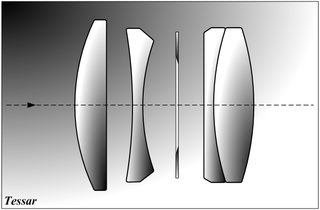
The Tessar is a photographic lens design conceived by the German physicist Dr. Paul Rudolph in 1902 while he worked at the Zeiss optical company and patented by Zeiss in Germany; the lens type is usually known as the ZeissTessar. Since its introduction, millions of Tessar and Tessar-derived lenses have been manufactured by Zeiss and other manufacturers, and are still produced as excellent intermediate aperture lenses.

A fisheye lens is an ultra wide-angle lens that produces strong visual distortion intended to create a wide panoramic or hemispherical image. Fisheye lenses achieve extremely wide angles of view, well beyond any rectilinear lens. Instead of producing images with straight lines of perspective, fisheye lenses use a special mapping, which gives images a characteristic convex non-rectilinear appearance.

Voigtländer was a significant long-established company within the optics and photographic industry, headquartered in Braunschweig, Germany, and today continues as a trademark for a range of photographic products.

Contax began as a German camera model in the Zeiss Ikon line in 1932, and later became a brand name. The early cameras were among the finest in the world, typically featuring high quality Zeiss interchangeable lenses. The final products under the Contax name were a line of 35 mm, medium format, and digital cameras engineered and manufactured by Japanese multinational Kyocera, and featuring modern Zeiss optics. In 2005, Kyocera announced that it would no longer produce Contax cameras. The rights to the brand are currently part of Carl Zeiss AG, but no Contax cameras are currently in production, and the brand is considered dormant.

Jos. Schneider Optische Werke GmbH is a manufacturer of industrial and photographic optics. The company was founded on 18 January 1913 by Joseph Schneider as Optische Anstalt Jos. Schneider & Co. at Bad Kreuznach in Germany. The company changed its name to Jos. Schneider & Co., Optische Werke, Kreuznach in 1922, and to the current Jos. Schneider Optische Werke GmbH in 1998.
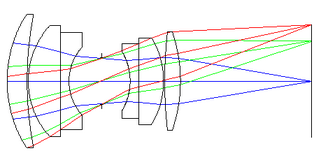
The double Gauss lens is a compound lens used mostly in camera lenses that reduces optical aberrations over a large focal plane.
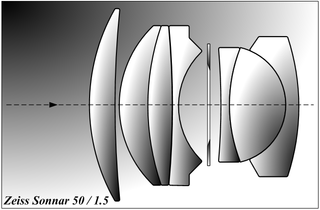
The Zeiss Sonnar is a photographic lens originally designed by Dr. Ludwig Bertele in 1929 and patented by Zeiss Ikon. It was notable for its relatively light weight, simple design and fast aperture.

Lens speed is the maximum aperture diameter, or minimum f-number, of a photographic lens. A lens with a larger than average maximum aperture is called a "fast lens" because it can achieve the same exposure as an average lens with a faster shutter speed. Conversely, a smaller maximum aperture is "slow" because it delivers less light intensity and requires a slower (longer) shutter speed.
Walter Mandler was a lens designer of Ernst Leitz Canada in Midland, Ontario. Mandler is credited with the design of more than 45 Leica lenses for the Leica rangefinder cameras and Leica SLR cameras.

The Leica CL is a 35mm compact rangefinder camera with interchangeable lenses in the Leica M-mount. It was developed in collaboration with Minolta who manufactured it. It first appeared in April 1973 and was released in the Japanese market in November 1973 as the Leitz Minolta CL. Both the Leica CL and Leitz Minolta CL were manufactured in a new Minolta factory in Osaka. In 2017, Leica announced a new digital mirrorless camera, again named Leica CL.
The design of photographic lenses for use in still or cine cameras is intended to produce a lens that yields the most acceptable rendition of the subject being photographed within a range of constraints that include cost, weight and materials. For many other optical devices such as telescopes, microscopes and theodolites where the visual image is observed but often not recorded the design can often be significantly simpler than is the case in a camera where every image is captured on film or image sensor and can be subject to detailed scrutiny at a later stage. Photographic lenses also include those used in enlargers and projectors.

Ludwig Jakob Bertele was a German optics constructor. His developments received universal recognition and serve as a basis for considerable part of the optical designs used today.
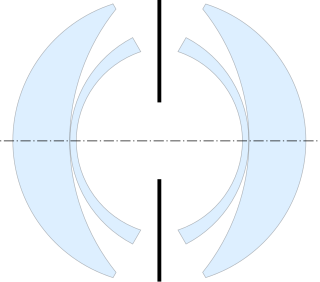
Topogon is a wide field, symmetrical photographic lens patented by Robert Richter in 1933 for Carl Zeiss AG. As there are four meniscus elements in four groups, deployed symmetrically around the central aperture, it is considered a double Gauss lens variant.

The invention of the camera in the early 19th century led to an array of lens designs intended for photography. The problems of photographic lens design, creating a lens for a task that would cover a large, flat image plane, were well known even before the invention of photography due to the development of lenses to work with the focal plane of the camera obscura.
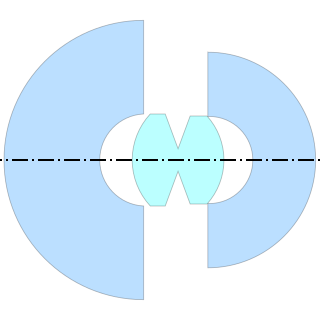
The Zeiss Hologon is an ultra wide-angle f=15mm f/8 triplet lens, providing a 110° angle of view for 35mm format cameras. The Hologon was originally fitted to a dedicated camera, the Zeiss Ikon Contarex Hologon in the late 1960s; as sales of that camera were poor and the Zeiss Ikon company itself was going bankrupt, an additional 225 lenses were made in Leica M mount and released for sale in 1972 as the only Zeiss-branded lenses for Leica rangefinders until the ZM line was released in 2005. The Hologon name was revived in 1994 for a recomputed f=16mm f/8 lens fitted to the Contax G series of rangefinder cameras.

Rodenstock Photo Optics traces its origins to a mechanical workshop founded in 1877 by Josef Rodenstock and his brother Michael in Würzburg, Germany. The company relocated to Munich by 1884 and became an important manufacturer of both corrective lenses for glasses and camera lenses by the early 1900s. These two lines began to diverge in the 1960s as the center of photographic lens manufacturing shifted to Japan; the ophthalmic business continued as Rodenstock GmbH while the remaining camera lens business was repositioned to serve the large format and industrial precision optics markets, then spun off in 1996 as Rodenstock Präzisionsoptik. Since then, the precision optics brand has been acquired in succession by LINOS Photonics, Qioptiq Group, and Excelitas Technologies (2013).

The W Rokkor 21mm lenses are a series of three prime wide angle lenses produced by Minolta for Minolta SR-mount single lens reflex cameras. The first 21mm lens released was the W Rokkor-PI 21mm f/4.5 (1962), which featured a symmetrical design similar to the contemporary Zeiss Biogon. This was succeeded by the W Rokkor-QH 21mm f/4 (1963), with slightly improved speed and similar symmetric construction. The third and final 21mm lens was the MC W Rokkor-NL 21mm f/2.8 (1971), which featured a retrofocus design that did not require the reflex mirror to be locked up, allowing use of the built-in viewfinder.